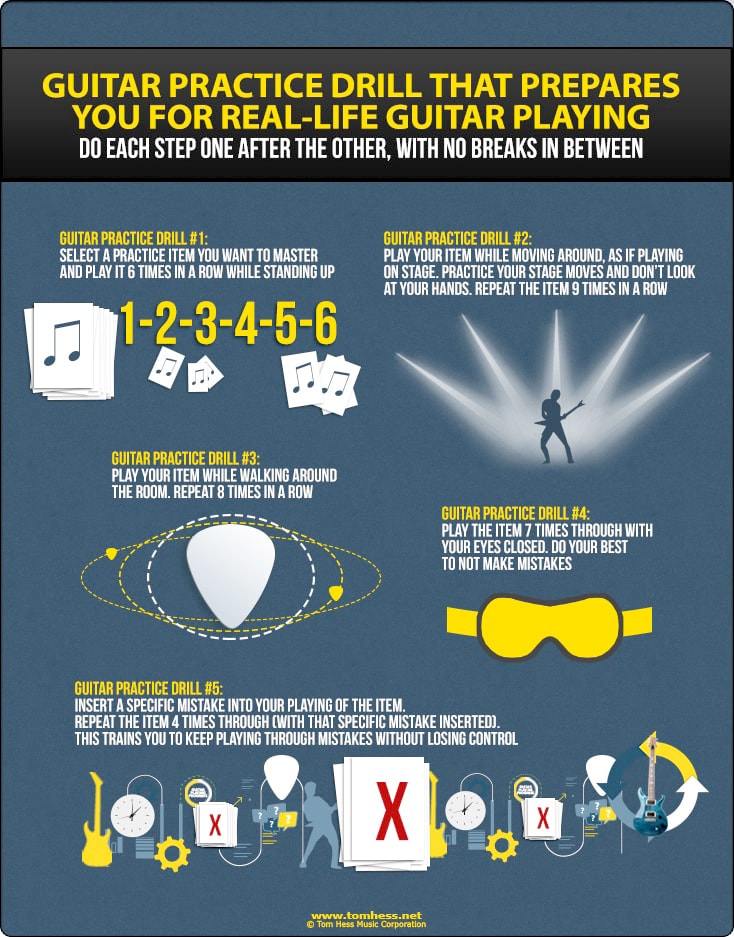What is the most effective way to see how well you can play a certain thing on guitar? Answer: see how well you can play when in live situations – This is what I call “real life guitar playing”.
Real-life guitar playing can best be described as the following:
*Performing live in front of other people without making any mistakes
*Playing guitar at your very best even you're playing is off
To practice for real-life musical scenarios, you’ll have to:
1. Train yourself in order to play at your very best in any situation. This free resource helps make your guitar playing more consistent and reliable.
2. Use a guitar practice circuit to practice for playing in live scenarios. A practice circuit can be made for your particular needs, goals and skill level. Guitar practice circuit training is also fun and efficient. This article discusses how guitar practicing circuits help your guitar playing.

The guitar practice circuit below gets you read to perform in any situation. Use a metronome to keep pace. Play everything at the original tempo unless given instruction to do otherwise.
Step 1: Play a specific practice item while standing for six total repetitions.
Step 2: Now play that same practice item while moving your hands as you play. For example, tilt your guitar up or make gestures with your hands after playing a note. Do this for nine repetitions, but only while playing the item from step one.
Note: If you aren’t sure what kind of movements to make, watch videos of your favorite guitar players.
Once you’ve done this, quickly do this:
Step 3: Walk around the room as you play. Repeat this eight times one after the other.
Once you’ve done this, quickly do this:
Step 4: Now close your eyes and play the item seven times. Although mistakes are inevitable, try to play as perfectly as possible. Even if you make a mistake, keep playing.
Once you’ve done this, quickly do this:
Step 5: Intentionally make a mistake while you are playing. You read that right: think of a particular mistake and insert it into whatever you are playing on purpose. Repeat the practice item four times in this manner.
Once you’ve done this, quickly do this:
Step 6: Turn up your metronome to play the practice item 15 beats per minute faster than usual. Repeat this five times.
(Unsure about what the top speed of consistent and reliable playing is? Get this guitar speed building resource.)
Repeat this complete practice circuit for 25 minutes and then stop.
How This Guitar Practice Circuit Gets You Prepared For Real-Life Musical Scenarios:
Practicing Guitar As You Stand:
Performing live almost always requires standing. It’s harder to stand and play guitar than it is to sit and do so. The guitar feels less stable as you stand. This makes it more difficult to play.
Practicing guitar standing up makes it easier to perform well.
Practicing Guitar With Movement:
The best performances always involve movement and expression using one’s body. Merely playing the right notes is just not enough to play a great live show. You express yourself more clearly by moving.
Practicing Guitar As You Walk:
Walking around while performing challenges you to play accurately and reliably. This makes you a better performer on stage.
Practicing Guitar With Eyes Shut:
A lot of guitar players spend too much time watching their hands as they play. On stage, you aren’t always going to be able to see yourself as you play. It might be totally dark, or there may be lights in your eyes. When you practice playing guitar with eyes shut, it helps you prepare for this situation.
Practicing Guitar At A Faster Tempo:
When you play something at a faster tempo, it makes it much easier to play at its original speed.
Practicing Guitar By Inserting Mistakes On Purpose:
Making mistakes is inevitable in live settings. However, when you train yourself to continue playing even after making mistakes, you won’t be distracted by them during live performances.
Question: “Tom Hess, what are some of the mistakes you can put in your playing?”
Answer: Think of the kinds of mistakes that would naturally occur as you play. For instance, string noises, notes being played at the same time when they shouldn’t be, playing everything out of sync, bad timing and using out of tune bends.
Additional Ways To Practice Guitar And Prepare For Real-Life Scenarios
Idea #1: Stand right next to the amp and turn the volume knob up much higher than usual. Playing next to a loud amp feels different than keeping it at quieter settings. You need to feel the sound blasting in your face to simulate what you will sometimes experience playing on stage.
Idea #2: Turn on the amp at normal volume, but move away from it. For example, walk out of the room and shut the door. This will muffle the sound, making it harder to hear (and simulating a volume situation that sometimes happens during a live performance).
Idea #3: Play to a backing track and have the backing chords/parts turned up too high. This happens commonly during live shows and you have to be able to adjust.
When you have mastered the ability to play in these musical situations, you feel more confident as a musician. This leads to better live performances.
Warning: don’t replace your preexisting practice strategies with this circuit. Instead, use it together with them over the course of a month. Have fun with this practice circuit and enjoy the great results it gives for live performance.
This free resource helps to make your guitar playing more consistent and reliable.
About The Author:
Tom Hess is a professional touring musician, composer and successful rock/metal guitar teacher. He helps guitarists around the world learn to play guitar online. On his website tomhess.net, you can find guitar playing tips, free guitar resources and more guitar articles.
Post new comment
Please Register or Login to post new comment.